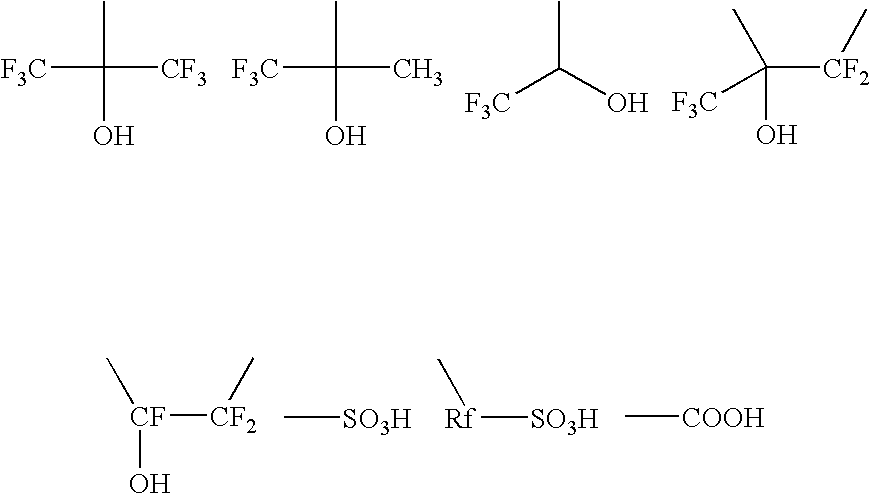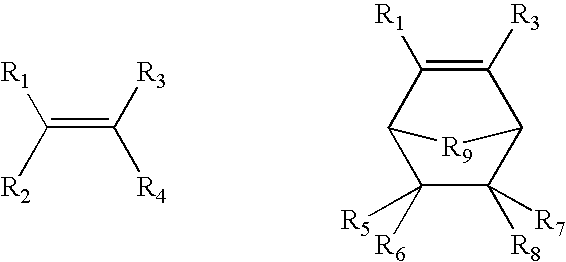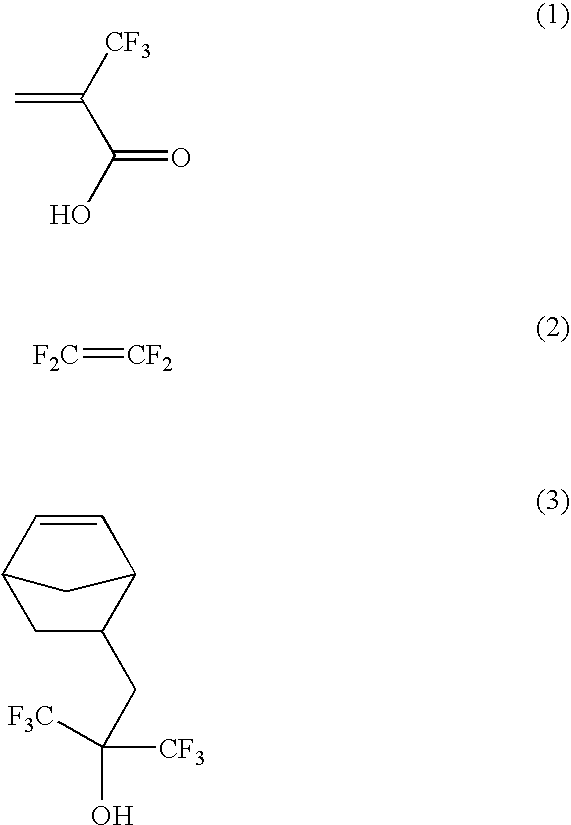Process for producing top coat film used in lithography
a lithography and top coat technology, applied in the field of fluorine-containing polymers, can solve the problems of not reaching the level at which the material is optimized, deficient in solubility in developing solutions,
- Summary
- Abstract
- Description
- Claims
- Application Information
AI Technical Summary
Benefits of technology
Problems solved by technology
Method used
Image
Examples
example 1
Synthesis of Polymer Compound (A)
[0046]
[0047] A 500 ml autoclave made of SUS was charged with 14 g of the above monomer (1), 27 g of the above monomer (3), 0.5 g of PERBUTYL D made by NOF CORPORATION as the initiator, 1 g of n-dodecylmercaptane, and 180 g of t-butanol, followed by replacement with nitrogen and then charging with 10 g of the above monomer (2). This was heated in an oil bath of 130° C. and stirred for 18 hr. After the termination of the reaction, the reaction solution was put into 1 liter of water / methanol (9 / 1), followed by stirring. The generated precipitate was filtered and taken out. Then, the precipitate was dissolved in isopropyl alcohol, followed by putting again into 1 liter of water / methanol (9 / 1) and then stirring. The generated precipitate was filtered and taken out. It was dried at 60° C. for 24 hr, thereby obtaining 21 g of Polymer Compound (A) in a white-color solid. The weight average molecular weight was determined by GPC (standard: polystyrene) to be...
example 2
Synthesis of Polymer Compound (B)
[0048]
[0049] A 500 ml round-bottom flask equipped with a reflux condenser and a stirrer was charged with 10 g of the above monomer (4), 16 g of the above monomer (5), 22 g of the above monomer (6), 1.5 g of azobisisobutyronitrile (AIBN), 1.0 g of n-dodecylmercaptane, and 200 g of acetone, followed by replacement of the flask inside with nitrogen. This was heated in an oil bath of 75° C. and stirred for 18 hr. After the termination of the reaction, the reaction solution was put into 1 liter of water / methanol (9 / 1), followed by stirring. The generated precipitate was filtered and taken out. Then, the precipitate was dissolved in isopropyl alcohol, followed by putting again into 1 liter of water / methanol (9 / 1) and then stirring. The generated precipitate was filtered and taken out. It was dried at 60° C. for 24 hr, thereby obtaining 28 g of Polymer Compound (B) in a white-color solid. The weight average molecular weight was determined by GPC (standard:...
example 3
Synthesis of Polymer Compound (C)
[0050]
[0051] A 500 ml round-bottom flask equipped with a reflux condenser and a stirrer was charged with 21 g of the above monomer (1), 41 g of the above monomer (7), 1.6 g of azobisisobutyronitrile (AIBN), 1.0 g of n-dodecylmercaptane, and 200 g of acetone, followed by replacement of the flask inside with nitrogen. This was heated in an oil bath of 75° C. and stirred for 18 hr. After the termination of the reaction, the reaction solution was put into 1 liter of water / methanol (9 / 1), followed by stirring. The generated precipitate was filtered and taken out. Then, the precipitate was dissolved in isopropyl alcohol, followed by putting again into 1 liter of water / methanol (9 / 1) and then stirring. The generated precipitate was filtered and taken out. It was dried at 60° C. for 24 hr, thereby obtaining 25 g of Polymer Compound (C) in a white-color solid. The weight average molecular weight was determined by GPC (standard: polystyrene) to be 9,800.
PUM
| Property | Measurement | Unit |
|---|---|---|
| boiling point | aaaaa | aaaaa |
| wt % | aaaaa | aaaaa |
| carbon number | aaaaa | aaaaa |
Abstract
Description
Claims
Application Information
 Login to View More
Login to View More - R&D
- Intellectual Property
- Life Sciences
- Materials
- Tech Scout
- Unparalleled Data Quality
- Higher Quality Content
- 60% Fewer Hallucinations
Browse by: Latest US Patents, China's latest patents, Technical Efficacy Thesaurus, Application Domain, Technology Topic, Popular Technical Reports.
© 2025 PatSnap. All rights reserved.Legal|Privacy policy|Modern Slavery Act Transparency Statement|Sitemap|About US| Contact US: help@patsnap.com



